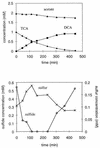Reductive dehalogenation of trichloroacetic acid by Trichlorobacter thiogenes gen. nov., sp. nov
- PMID: 10831402
- PMCID: PMC110515
- DOI: 10.1128/AEM.66.6.2297-2301.2000
Reductive dehalogenation of trichloroacetic acid by Trichlorobacter thiogenes gen. nov., sp. nov
Abstract
A bacterium able to grow via reductive dechlorination of trichloroacetate was isolated from anaerobic soil enrichments. The isolate, designated strain K1, is a member of the delta proteobacteria and is related to other known sulfur and ferric iron reducers. In anaerobic mineral media supplemented with acetate and trichloroacetate, its doubling time was 6 h. Alternative electron donor and acceptors were acetoin and sulfur or fumarate, respectively. Trichloroacetate dehalogenation activity was constitutively present, and the dechlorination product was dichloroacetate and chloride. Trichloroacetate conversion seemed to be coupled to a novel sulfur-sulfide redox cycle, which shuttled electrons from acetate oxidation to trichloroacetate reduction. In view of its unique physiological characteristics, the name Trichlorobacter thiogenes is suggested for strain K1.
Figures






Comment in
-
Trichlorobacter thiogenes should be renamed as a Geobacter species.Appl Environ Microbiol. 2001 Feb;67(2):1020-2. doi: 10.1128/AEM.67.2.1020-1022.2001. Appl Environ Microbiol. 2001. PMID: 11270361 Free PMC article. No abstract available.
References
-
- Bergmann J G, Sanik J., Jr Determination of trace amounts of chlorine in naphta. Anal Chem. 1957;29:241–243.
-
- Egli C, Thüer M, Suter D, Cook A M, Leisinger T. Monochloro- and dichloroacetic acids as carbon and energy sources for a stable, methanogenic mixed culture. Arch Microbiol. 1989;152:218–223.
-
- Felsenstein J. Evolutionary trees from DNA sequences: A maximum likelihood approach. J Mol Evol. 1981;17:368–376. - PubMed
Publication types
MeSH terms
Substances
Associated data
- Actions
Grants and funding
LinkOut - more resources
Full Text Sources
Molecular Biology Databases

